Overview
In today's digital landscape, developers face significant challenges in ensuring the security and reliability of their infrastructure. The article titled "13 Essential Terraform Scanning Tools for Secure Infrastructure" addresses these challenges by identifying key tools that enhance infrastructure management with Terraform. Among these tools are TFlint, Open Policy Agent, and Checkov, each designed to detect vulnerabilities, enforce compliance, and automate processes.
Furthermore, these scanning tools play a crucial role in maintaining secure and efficient infrastructure management practices. By leveraging their functionalities, developers can significantly improve their security posture and streamline operations. Imagine the peace of mind that comes with knowing your infrastructure is safeguarded against potential threats.
In addition, the benefits of utilizing these tools extend beyond mere compliance; they foster a culture of proactive security management. As developers integrate these tools into their workflows, they can enhance productivity and ensure high-quality code. Why not explore the advantages these tools offer and transform your infrastructure management today?
By focusing on these essential scanning tools, developers can not only meet compliance standards but also create a more resilient infrastructure. The importance of adopting such practices cannot be overstated, as they are vital for the long-term success and security of any organization.
Introduction
In the ever-evolving landscape of infrastructure management, developers face numerous challenges that can hinder their efficiency. How can these obstacles be overcome? Enter Kodezi, a tool designed to automate API documentation, which addresses these coding challenges head-on. By streamlining documentation processes, Kodezi not only saves time but also enhances code quality, leading to improved productivity.
As organizations strive for efficiency and reliability, tools like TFlint and Open Policy Agent ensure security compliance, while Terrascan, Checkov, and Tfsec are indispensable for identifying vulnerabilities. These innovative solutions are transforming how developers approach their workflows. Furthermore, with the rise of automated testing frameworks such as Terratest, teams can proactively validate their infrastructure, minimizing the risk of errors.
This article delves into the essential tools that are shaping the future of Terraform infrastructure management. It highlights their features, benefits, and real-world applications, empowering developers to build robust and secure systems. Are you ready to explore the tools available on the Kodezi platform and elevate your coding practices?
Kodezi | Professional OpenAPI Specification Generator - AI Dev-Tool: Enhance Code Quality and Productivity
Developers often face significant challenges in managing API documentation, which can be a tedious and error-prone process. Kodezi stands out as a robust platform that automates the generation of OpenAPI specifications, effectively addressing these challenges. By utilizing Kodezi, developers can ensure their programming meets professional standards, significantly elevating the quality and documentation of APIs. This tool allows developers to concentrate on building robust applications rather than getting mired in tedious manual documentation tasks.
Furthermore, Kodezi's capability to produce comprehensive API documentation directly from existing codebases conserves valuable time and minimizes the risk of errors. This ensures that API documentation remains consistently up-to-date and accurate. In addition, Kodezi's collection of developer tools automates reviews and keeps API documentation synchronized with modifications, further enhancing productivity. User testimonials highlight Kodezi's impact on debugging efficiency and productivity enhancement, with over 1,000,000 users praising its user-friendly features.
For those looking to implement Kodezi for API documentation, consider integrating it into your existing workflows. This will streamline the documentation process and maximize efficiency. Why not explore the tools available on the platform and see how Kodezi can transform your coding practices?
TFlint: Ensure Best Practices with Terraform Linting
Developers often face significant challenges when managing coding errors and adhering to best practices. TFlint serves as one of the terraform scanning tools, acting as a powerful linter for Terraform scripts by meticulously checking for common errors, deprecated syntax, and compliance with established standards. By automating the linting process and integrating into your CI/CD pipeline, TFlint empowers teams to identify and rectify issues before they escalate to production. This proactive approach not only enhances software quality but also cultivates a culture of best practices within development teams.
Furthermore, tools like Kodezi CLI play a crucial role in enhancing software quality through automated testing and debugging. Kodezi CLI focuses on identifying issues in your code before each push, allowing developers to address problems swiftly and maintain a stable codebase. This integration of automated tools into the release process is essential for improving performance and ensuring security compliance, enabling teams to deploy software with confidence.
A notable case study involves Picnic Technologies, which sought to enhance its grocery delivery logistics technology. By integrating TFlint along with terraform scanning tools into their CI/CD workflows, they successfully automated resource management, allowing developers to focus on more significant tasks. This transformation highlights the critical role of TFlint in promoting efficient development practices.
As of 2025, TFlint continues to evolve, with updates that enhance its capabilities in identifying linting errors and ensuring adherence to defined best practices. Developers have praised TFlint for its ability to instill confidence in managing configurations, solidifying its reputation as an essential tool for maintaining high standards in code management.
Open Policy Agent (OPA): Enforce Policies for Secure Terraform Configurations
Open Policy Agent (OPA) serves as a powerful open-source policy engine designed to enforce policies across your infrastructure configurations. Are you concerned about compliance with safety and security standards? By establishing guidelines within OPA, you can ensure adherence to these essential standards. Furthermore, this tool utilizes terraform scanning tools that integrate seamlessly with infrastructure as code, allowing you to assess policies during the planning stage. This proactive approach helps you avoid misconfigurations and vulnerabilities before they occur. OPA's flexibility in policy formulation makes it a vital asset for organizations seeking to enhance their security posture.

Terrascan: Identify Vulnerabilities in Terraform Code
In today's development landscape, the challenge of coding vulnerabilities is more pressing than ever. Terrascan serves as an essential static analysis tool designed to scrutinize infrastructure scripts for vulnerabilities and compliance breaches. By seamlessly integrating Terrascan into your development workflow, you can proactively identify potential risks in your infrastructure as software before deployment. This approach not only ensures that your infrastructure configurations adhere to industry standards and best practices but also significantly diminishes the likelihood of safety-related incidents.
Furthermore, as of 2025, the relevance of vulnerabilities identified by static analysis tools like Terrascan has intensified, highlighting the critical need for regular updates to safety protocols. For instance, Terrascan's codebase reveals that 83.1% is built on Open Policy Agent, showcasing its robust foundation for compliance. Current trends indicate a rise in incidents related to Infrastructure as Code (IaC), making the role of terraform scanning tools like Terrascan indispensable. Industry leaders emphasize that static analysis is crucial for uncovering vulnerabilities, with experts advocating for its integration into the development lifecycle to bolster protective measures.
Similarly, case studies illustrate Terrascan's effectiveness in pinpointing vulnerabilities within configuration files, reinforcing its significance in maintaining secure infrastructure. By utilizing Terrascan, organizations can not only comply with established standards but also foster a culture of proactive risk management, ultimately leading to a more secure and resilient IT environment.
Checkov: Static Analysis for Security and Compliance in Terraform
Developers today face significant challenges when it comes to ensuring the security and compliance of their code. Checkov is an open-source static analysis tool specifically designed to identify vulnerabilities and compliance issues within infrastructure as code. By scanning configurations against a robust set of policies, Checkov enables teams to detect misconfigurations and vulnerabilities early in the development cycle. This proactive strategy not only improves protection but also simplifies the deployment process.
Incorporating Checkov into CI/CD pipelines demonstrates its effectiveness. It enables automated scanning of Infrastructure as Code (IaC) files prior to their deployment in production environments. This integration greatly minimizes the risk of vulnerabilities, ensuring that compliance and safety issues are handled swiftly.
Key features of Checkov include its capability to enforce best practices for infrastructure as code, such as securely managing credentials and scanning files for potential threats. Did you know that Checkov boasts a high success rate in detecting vulnerabilities? This makes it an essential part of any development workflow. Moreover, the prevent_destroy lifecycle meta-argument acts as a crucial safeguard, helping to prevent unintentional loss of important resource assets. As organizations increasingly adopt terraform scanning tools like Checkov, the current usage rates reflect a growing acknowledgment of their significance in maintaining secure and compliant infrastructure. In 2025, Checkov continues to evolve, with updates enhancing its capabilities and ensuring it remains at the forefront of infrastructure protection. By automating inspections, Checkov empowers developers to concentrate on creating robust solutions while preserving the integrity of their infrastructure.
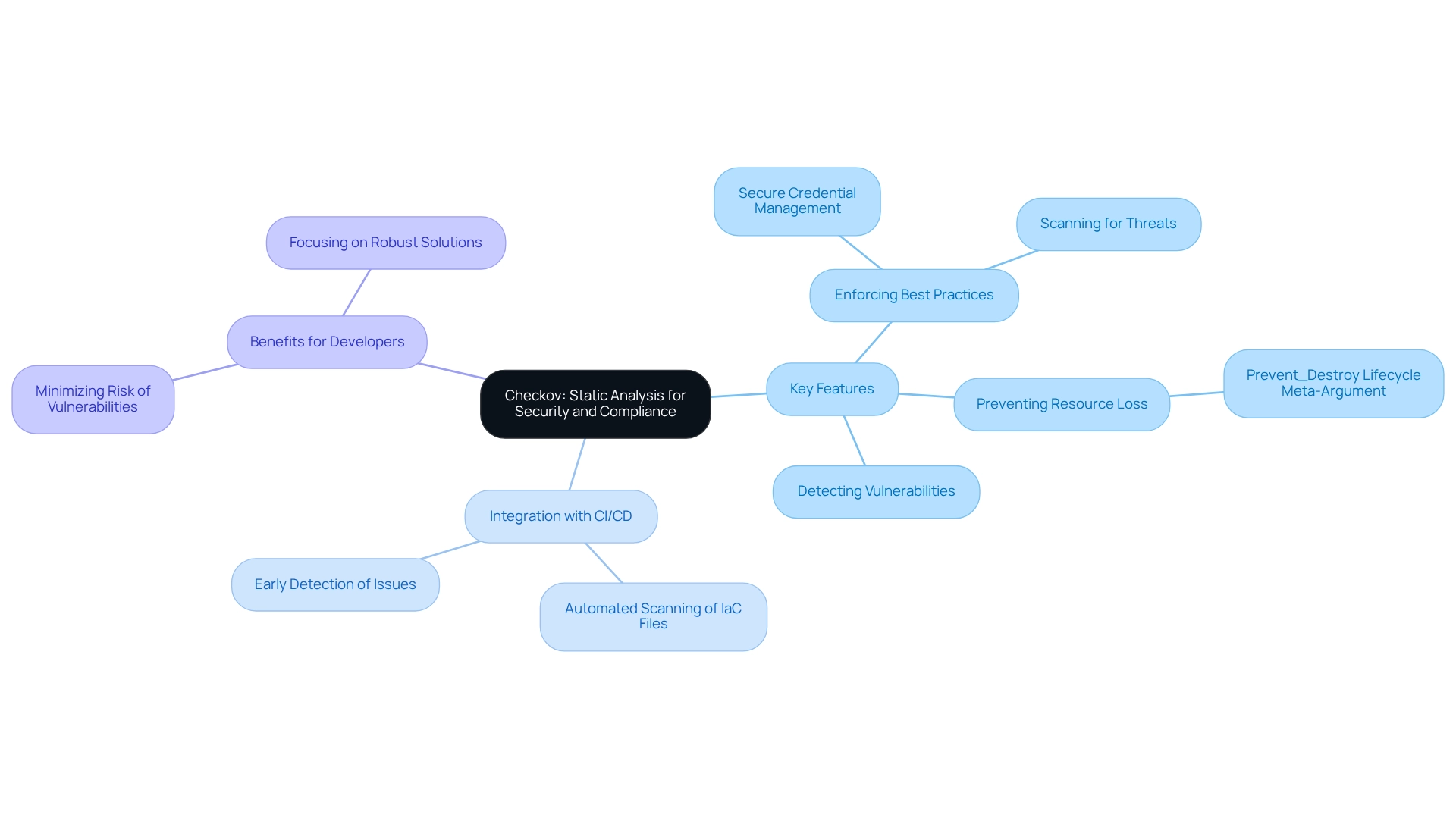
Tfsec: Scan Terraform Code for Security Issues
Developers face significant challenges in ensuring the security of their infrastructure as code. Tfsec emerges as a static analysis vulnerability scanner designed specifically for this purpose. It meticulously examines your Terraform configurations to uncover potential vulnerabilities and misconfigurations. By integrating Tfsec into your CI/CD pipeline, you can automate checks, allowing for the identification of issues before they escalate to production. This proactive approach not only enhances security but also supports the maintenance of a robust infrastructure, with current trends highlighting the importance of terraform scanning tools in automated verification processes in infrastructure as code, as exemplified by tools like Tfsec. A demonstration of Tfsec revealed its ability to detect vulnerabilities in an EC2 instance created with Terraform, providing practical solutions that bolster security. This case study illustrates how Tfsec not only identifies vulnerabilities but also contributes to the enhancement of protective practices within system architecture.
Tfsec offers customizable rule sets, allowing you to tailor the scanning process to meet your organization's specific security standards and requirements. Experts emphasize that proactive strategies in infrastructure as code are crucial for safeguarding applications and data.
As we look ahead to 2025, enhancements to the Tfsec scanner continue to improve its capabilities, ensuring it remains a top choice for developers committed to maintaining secure infrastructure code. By leveraging Tfsec, organizations can streamline their security processes and cultivate a culture of security-first development.
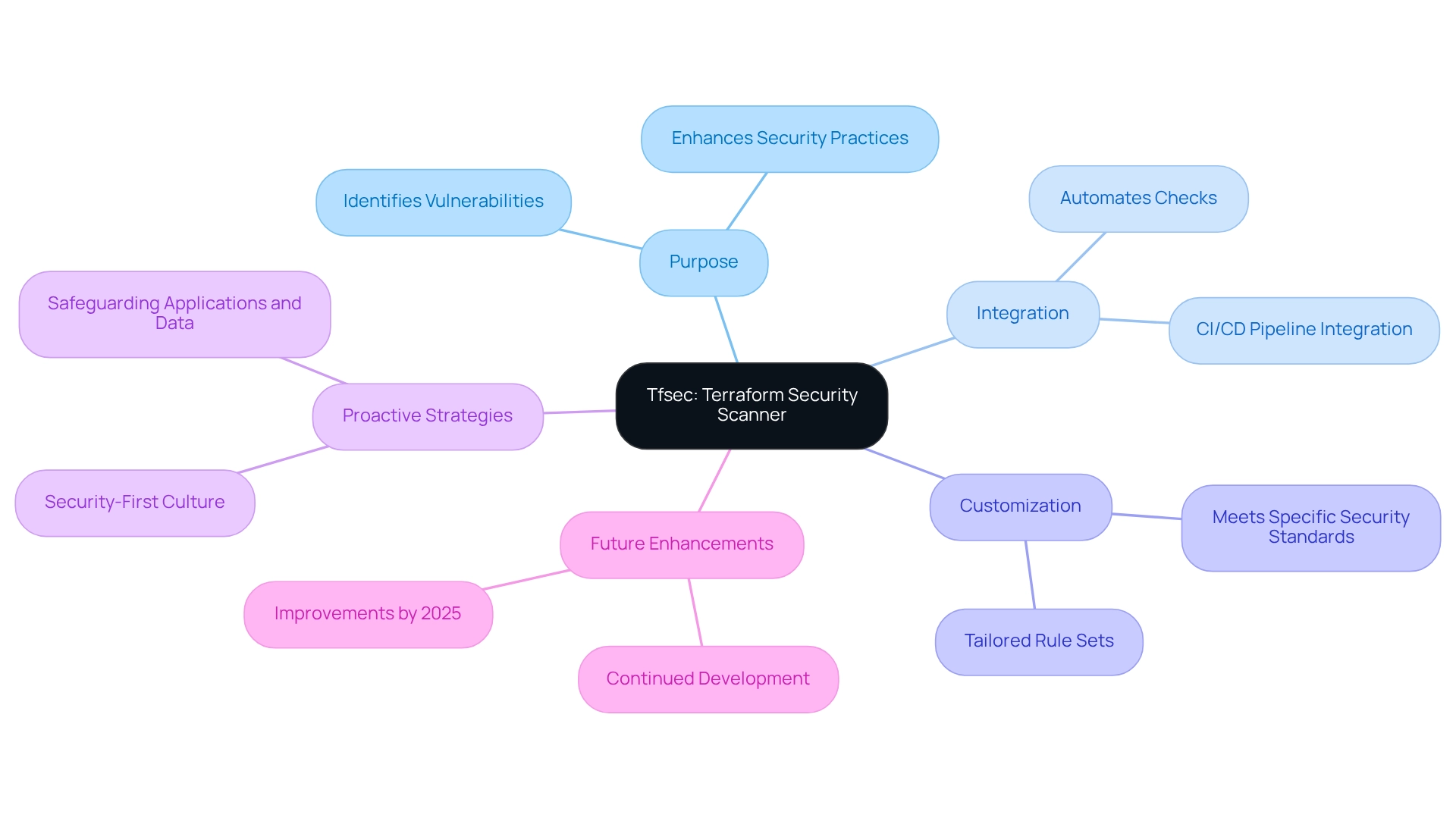
Terratest: Automate Testing for Reliable Terraform Infrastructure
In the realm of software development, coding challenges are a common hurdle that developers face. Automated testing has emerged as a crucial solution to these challenges, especially when utilizing terraform scanning tools in Terraform setups. Terratest, a robust Go library, simplifies this process by providing a collection of patterns and support functions that allow developers to generate automated tests for their system code. This proactive approach ensures that changes do not introduce regressions or errors, greatly enhancing confidence in deployments and reducing the risk of downtime or failures.
As organizations increasingly adopt testing frameworks like Terratest in their DevOps workflows, the value of integrating testing becomes clear. Automated testing not only improves reliability but also accelerates the development process. This enables teams to focus on creating innovative solutions rather than troubleshooting issues. For instance, have you considered how much time your team could save by implementing automated testing using Terraform scanning tools? Expert insights underline the significance of automated testing for Terraform systems. Developers have found that utilizing Terratest leads to more dependable system scripts, as it systematically identifies potential issues before they escalate into major complications. A case study on Kodezi illustrates this point, showing how automated code debugging and optimization tools can enhance developer productivity by swiftly pinpointing and resolving problems, thereby improving overall code quality.
Statistics reveal that automated testing can reduce system errors by as much as 30%, showcasing its effectiveness in maintaining strong and secure environments. As organizations continue to embrace automation, terraform scanning tools such as Terratest will be indispensable in ensuring that systems remain reliable and efficient. This facilitates smoother deployments and bolsters operational stability. Are you ready to explore how Terratest can transform your development process?
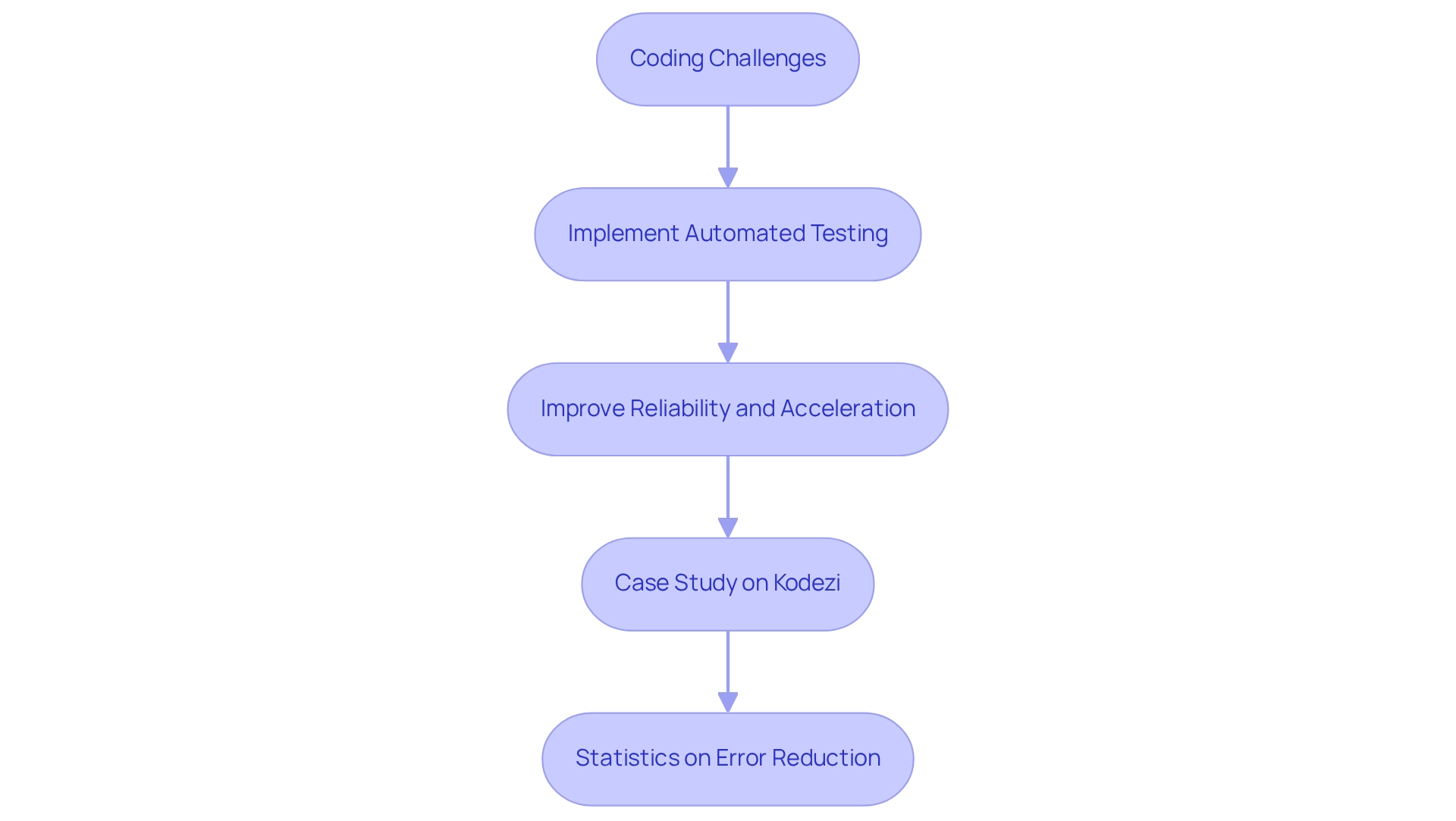
Infracost: Optimize Costs for Terraform Deployments
Infracost plays a crucial role in providing cost estimates for Terraform projects, enabling teams to grasp the financial implications of their system changes. By integrating Infracost into your workflow, you can foresee potential cost increases before deploying changes, which leads to better budget management and resource optimization. This proactive approach to cost estimation is vital, as it empowers teams to make informed decisions regarding their investments in infrastructure.
Moreover, accurate cost estimation is increasingly important in managing large-scale projects. Research indicates that half of the surveyed businesses migrated to the cloud primarily for disaster recovery, underscoring the need for effective budgeting and resource allocation. Financial analysts emphasize that sound cost management is key to sustainable development, with 43.5% of companies employing a cloud finance ops team to oversee these initiatives.
Infracost not only assists in cost optimization but also acts as a strategic tool in navigating the complexities of cloud financial management. As organizations strive to monitor resource usage and evaluate computing demands effectively, Infracost becomes an essential asset. Additionally, cloud cost management tools are critical for helping organizations optimize their resource utilization and minimize unnecessary expenses, positioning Infracost as a vital component in the competitive realm of cloud financial management.

Driftctl: Detect Configuration Drift in Terraform Infrastructure
For developers, maintaining consistency in Terraform configurations can be a significant challenge, which is where terraform scanning tools can help. Driftctl is a command-line tool designed to address this issue by identifying drift between your Terraform configurations and the actual state of your system. By frequently executing Driftctl, teams can uncover inconsistencies that may arise from manual modifications or external influences. This proactive approach ensures that Terraform-managed systems are secure and reliable through the use of terraform scanning tools.
Furthermore, using Driftctl as one of the terraform scanning tools is essential for preserving the integrity of your Infrastructure as Code (IaC) practices. By integrating this tool into your workflow, you can enhance your system's stability and safeguard against potential misconfigurations.
Have you considered how often your configurations might drift? Exploring Driftctl could be the key to maintaining control over your infrastructure.
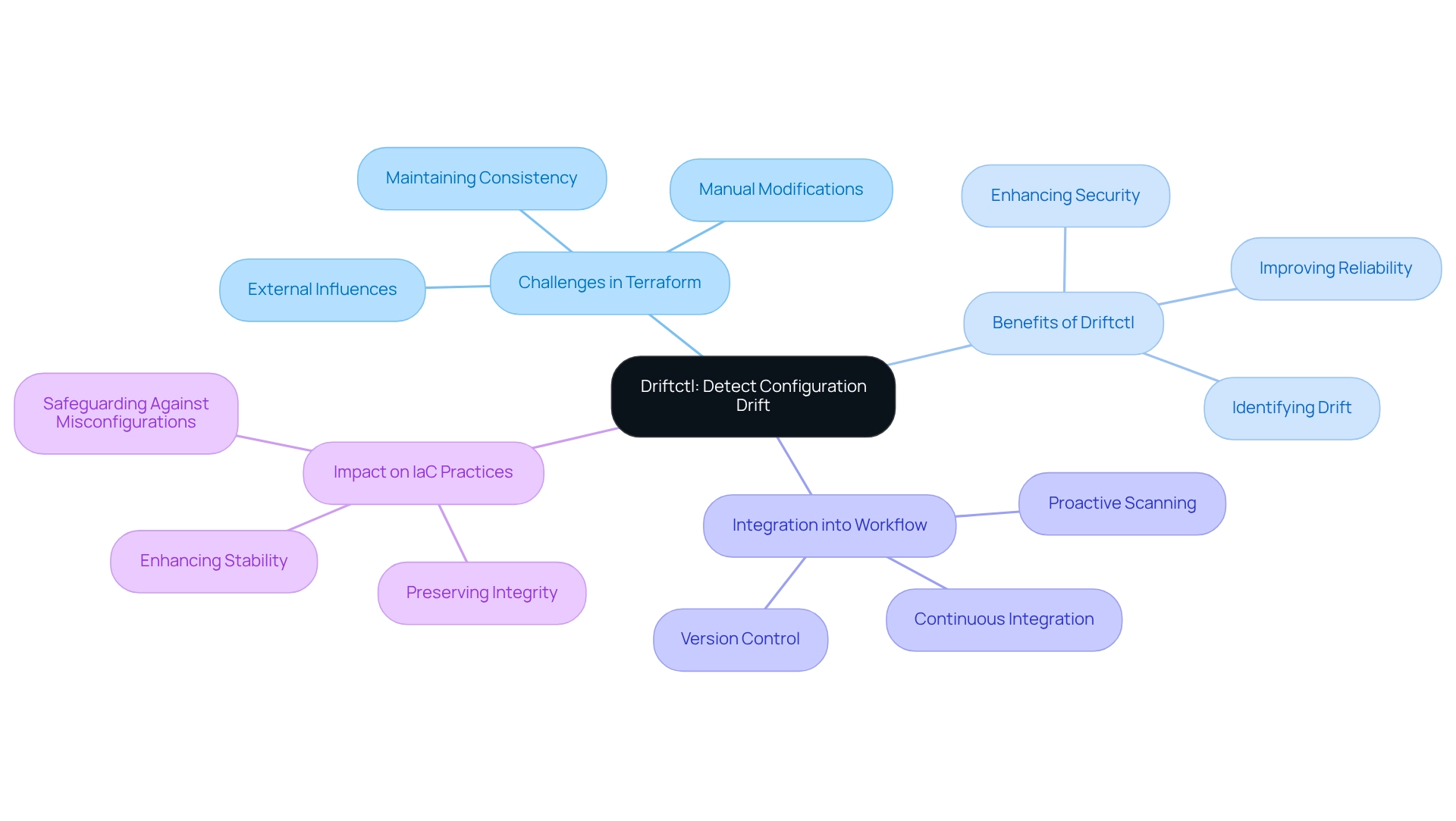
Terraformer: Import Existing Infrastructure into Terraform
Managing infrastructure can be a daunting challenge for many organizations. Terraformer emerges as a robust command-line utility designed to assist in importing current systems into the infrastructure-as-code (IaC) tool. By automatically generating configuration and state files from existing resources, Terraformer simplifies the transition to code-based systems. This capability is particularly advantageous for organizations aiming to implement IaC without the cumbersome task of manually replicating their current configurations, ultimately saving significant time and reducing the risk of errors during migration.
The adoption of IaC tools like Terraformer is gaining momentum, with recent statistics indicating that over 70% of organizations are incorporating IaC practices into their workflows. This trend underscores the growing recognition of the efficiency and reliability that IaC brings to systems management. Terraformer plays a pivotal role in this transition by enabling teams to utilize its features, such as marking resources for destruction and recreation with the taint command, which is essential for resolving issues.
Experts highlight the transformative impact of integrating current systems into the IaC framework. By leveraging Terraformer, teams can enhance their infrastructure management capabilities, ensuring that their configurations are not only precise but also compliant with industry standards. For instance, Nicholas Klick noted, "Since we're utilizing an infrastructure as code tool to establish those resources, we had that documentation and the visibility to link to each of those PCI requirements," emphasizing the critical role of documentation in compliance.
A case study on importing additional AWS resources illustrates how users can effortlessly expand their configurations, leading to improved resource management and visibility. The provided command syntax enables users to import various AWS resources, thereby enhancing their resource management capabilities.
As organizations progressively transition to infrastructure as code, using terraform scanning tools like Terraformer is essential for streamlining this process. By offering a clear method for importing existing setups, Terraformer not only accelerates the adoption of IaC but also allows teams to focus on optimizing their systems rather than getting bogged down by manual configuration tasks.
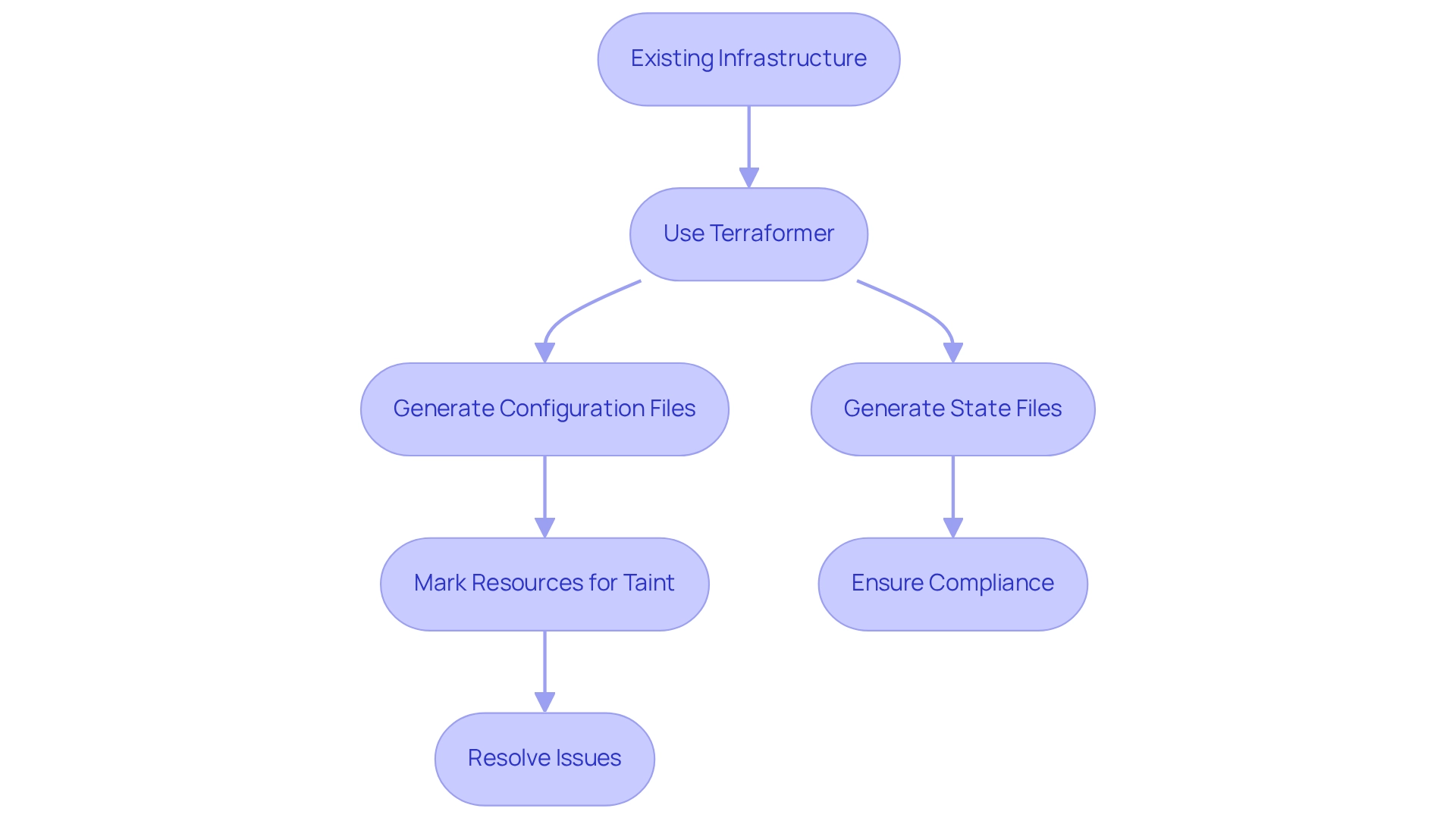
Blast Radius: Visualize Impact of Terraform Changes
In the realm of system management, understanding the potential effects of changes is crucial. Blast Radius, an open-source tool, excels in visualizing Terraform dependency graphs and serves as one of the essential terraform scanning tools, empowering teams to navigate these complexities. By mapping out dependencies, teams can effectively assess the risks associated with modifications, leading to more informed deployment decisions. This capability not only fosters teamwork and interaction among group members but also ensures that everyone comprehends the consequences of system changes.
Current trends indicate that teams utilizing terraform scanning tools, such as Blast Radius, experience a notable enhancement in managing their systems. Studies demonstrate that effective visualization can reduce deployment errors by as much as 30%. Furthermore, case studies reveal that organizations employing terraform scanning tools alongside Blast Radius for visualizing changes have significantly improved their management processes, cultivating a culture of transparency and proactive risk management. By leveraging such tools, teams can enhance their operational efficiency and collaboration.
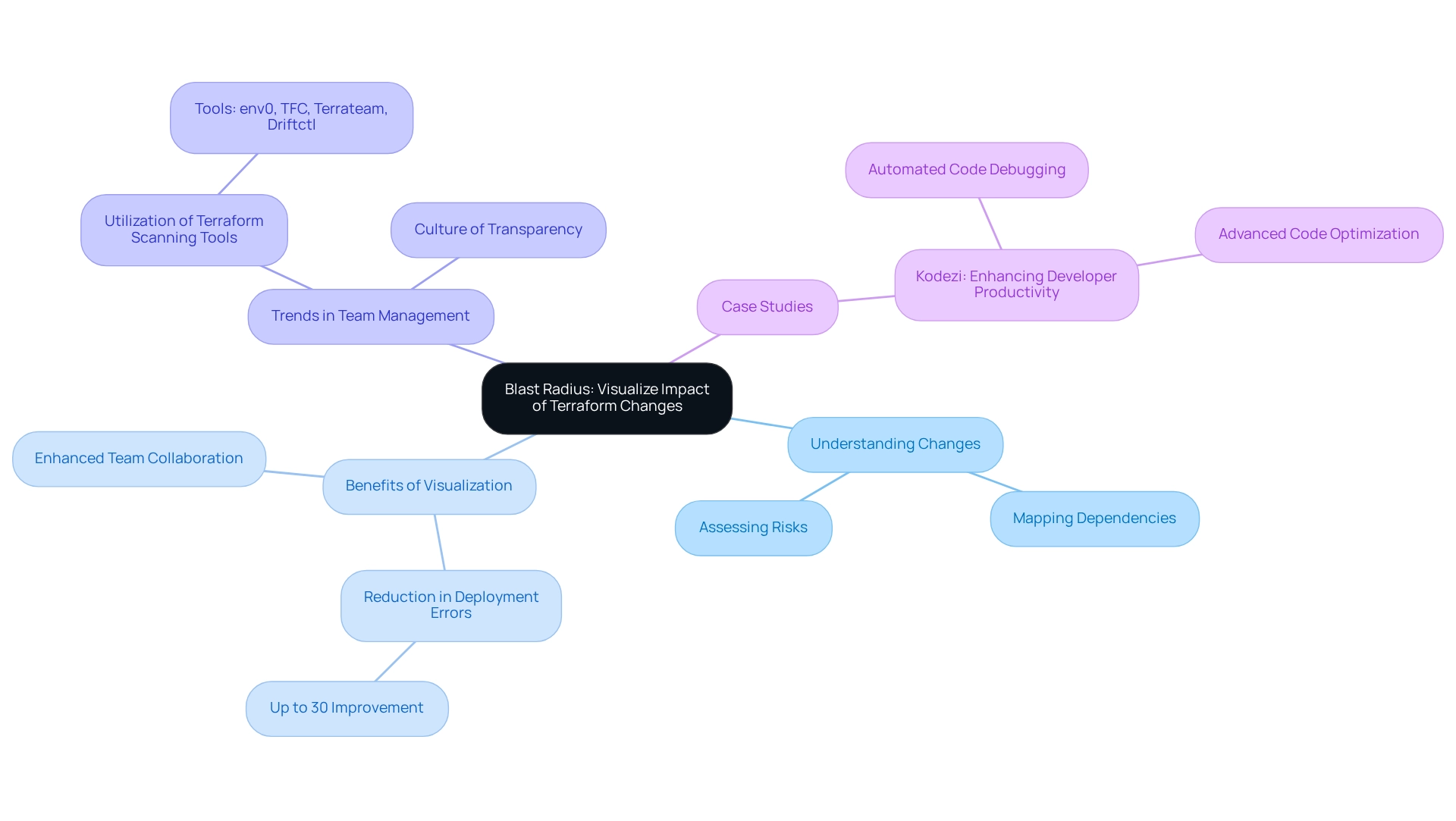
Terraform-docs: Automate Documentation for Terraform Modules
Coding challenges can be daunting for developers, especially when it comes to maintaining accurate documentation. Terraform scanning tools, such as Terraform-docs, emerge as powerful resources designed to automate the creation of documentation for infrastructure modules. By systematically analyzing input variables, output values, and resources, it produces comprehensive documentation in multiple formats. This automation not only significantly reduces the time spent on manual documentation but also ensures consistency and accuracy. These factors are crucial for effective collaboration among team members, allowing teams to uphold a high standard of programming quality, ultimately leading to more dependable infrastructure management.
The importance of consistent documentation in Terraform projects cannot be overstated. Regularly updated documentation fosters better communication and understanding within teams, enabling developers to work more efficiently. Have you considered how automated documentation tools can transform your workflow? Studies show that teams utilizing such tools experience marked improvements in collaboration and project outcomes. Kodezi enhances this process by automating reviews, maintaining API documentation in alignment with updates, and generating OpenAPI specifications. This further enables teams to oversee their projects efficiently.
For instance, a case study on the use of Terraform-docs revealed that teams implementing this automation saw a 30% reduction in onboarding time for new developers, as they could quickly access up-to-date documentation. Furthermore, industry leaders stress that thoroughly documented programming is essential for maintaining high standards in development. As Alexander Sharov, a Lead DevOps Engineer, states, "Documentation is the backbone of any successful project; it ensures that everyone is on the same page."
In 2025, the trend toward automating documentation for infrastructure modules continues to grow, with more teams recognizing its benefits. Statistics indicate that organizations leveraging automated documentation tools, like Kodezi, report a 40% increase in productivity. This underscores the value of integrating such solutions into development workflows. By adopting Terraform-docs alongside Kodezi, which also utilizes terraform scanning tools to automatically create a Swagger site for APIs, teams can enhance their documentation practices, streamline collaboration, and ultimately improve the quality of their code.
TFSwitch: Manage Multiple Terraform Versions Seamlessly
Managing multiple Terraform versions can be a significant challenge for developers, especially when working on diverse projects with varying version requirements. TFSwitch is a command-line tool designed to streamline this process, making it an essential asset for teams. By simplifying the version-switching process, TFSwitch enhances workflow efficiency and minimizes compatibility issues, allowing developers to focus on creating and deploying systems without interruptions from version conflicts.
Recent statistics highlight that alert fatigue is the single biggest problem in monitoring systems, illustrating the challenges developers face in managing infrastructure effectively. Tools like TFSwitch are increasingly utilized in projects, with high performers leveraging telemetry to inform their problem-solving strategies. This trend underscores the importance of effective version management in maintaining project integrity and security.
A significant case study features Terraformer, which examines cloud settings and produces configuration scripts for existing resources. While it aids in transitioning to Infrastructure as Code, it emphasizes the necessity for careful auditing of generated code to ensure quality and maintainability. Similarly, TFSwitch enables teams to manage their infrastructure as code versions effectively, addressing the challenges developers encounter in version control, and the use of terraform scanning tools is becoming a critical factor in project success as development teams prioritize the ability to seamlessly switch between Terraform versions. Expert opinions indicate that tools like TFSwitch not only facilitate smoother workflows but also enhance the overall security and dependability of management systems. By supporting a unified approach to infrastructure management, TFSwitch aligns with the needs of efficiency enthusiasts who seek to optimize their development processes.
Conclusion
The landscape of Terraform infrastructure management presents significant challenges for developers, particularly in maintaining security and optimizing workflows. Kodezi addresses these challenges head-on by automating API documentation, which not only enhances code quality but also boosts productivity. With tools like TFlint and Open Policy Agent, developers can ensure that best practices and security compliance are consistently upheld throughout the development process.
In addition, tools such as Terrascan, Checkov, and Tfsec are crucial for identifying vulnerabilities, ensuring that your infrastructure remains secure and robust. Automated testing frameworks like Terratest and cost management tools like Infracost are essential for optimizing both workflows and budgets. Furthermore, Driftctl and Terraformer provide effective solutions for maintaining consistency and facilitating the transition to infrastructure as code. Visualization tools like Blast Radius empower developers to make informed decisions by understanding the impacts of their changes.
The integration of these tools fosters a culture of proactive risk management and collaboration. As organizations increasingly embrace automation and best practices in their infrastructure management, the positive impact on productivity and security becomes evident. By leveraging these innovative solutions, developers can build resilient systems that not only meet today's demands but also prepare for the future.
In conclusion, the right combination of tools can significantly enhance the efficiency and reliability of Terraform infrastructure management. Embracing these technologies streamlines processes and empowers teams to focus on innovation, ultimately leading to better outcomes in their development endeavors. The future of coding practices is bright, and the tools available on the Kodezi platform are pivotal in shaping that future.
Frequently Asked Questions
What challenges do developers face in managing API documentation?
Developers often encounter significant challenges in managing API documentation, which can be a tedious and error-prone process.
How does Kodezi help with API documentation?
Kodezi automates the generation of OpenAPI specifications, allowing developers to ensure their programming meets professional standards and elevates the quality of API documentation.
What benefits does Kodezi provide to developers?
Kodezi allows developers to focus on building robust applications instead of manual documentation tasks, conserves time, minimizes errors, and keeps API documentation consistently up-to-date and accurate.
How does Kodezi enhance productivity?
Kodezi automates reviews and synchronizes API documentation with modifications, which enhances productivity and reduces the time spent on documentation.
What do users say about Kodezi?
User testimonials highlight Kodezi's positive impact on debugging efficiency and productivity enhancement, with over 1,000,000 users praising its user-friendly features.
How can developers implement Kodezi for API documentation?
Developers are encouraged to integrate Kodezi into their existing workflows to streamline the documentation process and maximize efficiency.




